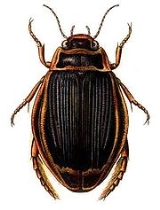
Dytiscus
Encyclopedia
Dytiscus (based on Greek
δυτικός, "able to dive") is a Holarctic
genus of predaceous diving beetles that usually live in wetland
s and pond
s. There are 26 species in this genus distributed in Europe, Asia, North Africa and North and Central America. They are predators that can reduce mosquito
larva
e.
Dytiscus species are large water beetles with a robust, rounded shape and are usually around two inches long. The tarsi of the males are modified into suckers which are used to grip the female in mating. Females are usually larger than the males and come in two forms, with grooved (sulcate) or smooth elytra. Males only ever have smooth elytra. The adults of most species can fly.
The larvae (known as "water tigers") are elongate with a round and flat head and strong mandibles. They are predatory and their mandible have grooves on their inner edge through which they are able to suck the body fluids of their prey. The larvae take air from the surface of the water using hairs at the end of their abdomen. These lead to spiracles into which the air is taken.
Once the larvae grow to some size, they move to soil at the edge of water and burrow into a cell and pupate.
The adults breathe by going to the surface and upending. They collect air under their elytra and are able to breathe this collected air using spiracles hidden under the elytra.
In Dytiscus marginalis and other species the tarsus of the forelegs is modified in males to form a circular sucker. A reduced sucker is also seen in the midleg of the male.
, Mymaridae and other Chalcidoidea.
Greek language
Greek is an independent branch of the Indo-European family of languages. Native to the southern Balkans, it has the longest documented history of any Indo-European language, spanning 34 centuries of written records. Its writing system has been the Greek alphabet for the majority of its history;...
δυτικός, "able to dive") is a Holarctic
Holarctic
The Holarctic ecozone refers to the habitats found throughout the northern continents of the world as a whole. This region is divided into the Palearctic, consisting of Northern Africa and all of Eurasia, with the exception of Southeast Asia and the Indian subcontinent, and the Nearctic,...
genus of predaceous diving beetles that usually live in wetland
Wetland
A wetland is an area of land whose soil is saturated with water either permanently or seasonally. Wetlands are categorised by their characteristic vegetation, which is adapted to these unique soil conditions....
s and pond
Pond
A pond is a body of standing water, either natural or man-made, that is usually smaller than a lake. A wide variety of man-made bodies of water are classified as ponds, including water gardens, water features and koi ponds; all designed for aesthetic ornamentation as landscape or architectural...
s. There are 26 species in this genus distributed in Europe, Asia, North Africa and North and Central America. They are predators that can reduce mosquito
Mosquito
Mosquitoes are members of a family of nematocerid flies: the Culicidae . The word Mosquito is from the Spanish and Portuguese for little fly...
larva
Larva
A larva is a distinct juvenile form many animals undergo before metamorphosis into adults. Animals with indirect development such as insects, amphibians, or cnidarians typically have a larval phase of their life cycle...
e.
Dytiscus species are large water beetles with a robust, rounded shape and are usually around two inches long. The tarsi of the males are modified into suckers which are used to grip the female in mating. Females are usually larger than the males and come in two forms, with grooved (sulcate) or smooth elytra. Males only ever have smooth elytra. The adults of most species can fly.
Life history
Adult beetles and their larvae are aquatic but the pupae spend their life in the ground. Females lay eggs inside the tissue of aquatic plants such as reeds. The eggs hatch in about three weeks.The larvae (known as "water tigers") are elongate with a round and flat head and strong mandibles. They are predatory and their mandible have grooves on their inner edge through which they are able to suck the body fluids of their prey. The larvae take air from the surface of the water using hairs at the end of their abdomen. These lead to spiracles into which the air is taken.
Once the larvae grow to some size, they move to soil at the edge of water and burrow into a cell and pupate.
The adults breathe by going to the surface and upending. They collect air under their elytra and are able to breathe this collected air using spiracles hidden under the elytra.
In Dytiscus marginalis and other species the tarsus of the forelegs is modified in males to form a circular sucker. A reduced sucker is also seen in the midleg of the male.
Parasitoids
Eggs of Dytiscus are sometimes parasitized by wasps of the families EulophidaeEulophidae
Eulophidae is a large family of hymenopteran insects, with over 4,300 described species in some 300 genera . The family as presently defined also includes the genus Elasmus, which was previously treated as a separate family, "Elasmidae", and is now treated as a subfamily of Eulophidae...
, Mymaridae and other Chalcidoidea.
Species
- Dytiscus circumcinctus
- Dytiscus circumflexus
- Dytiscus dimidiatus
- Dytiscus lapponicus
- Dytiscus latissimusDytiscus latissimusDytiscus latissimus is a species of beetle in family Dytiscidae. It is found in Austria, Belarus, Belgium, Bosnia and Herzegovina, Croatia, the Czech Republic, Denmark, Estonia, Finland, France, Germany, Hungary, Italy, Latvia, Lithuania, Luxembourg, the Netherlands, Norway, Poland, Romania,...
- Dytiscus marginalisDytiscus marginalisThe great diving beetle, Dytiscus marginalis, is a large aquatic diving beetle native to Europe and northern Asia, and is particularly common in England.The great diving beetle, true to its name, is a rather sizable insect...
- Dytiscus mutinensis
- Dytiscus persicus
- Dytiscus pisanus
- Dytiscus semisulcatus
- Dytiscus thianschanicus

